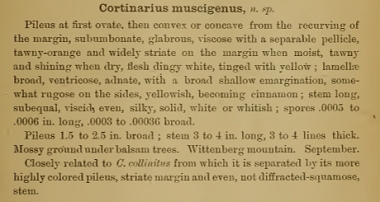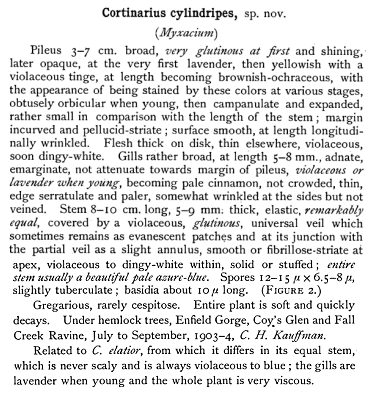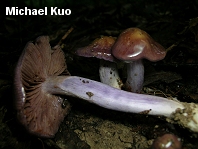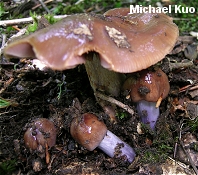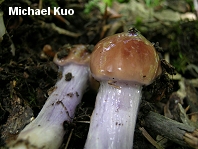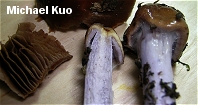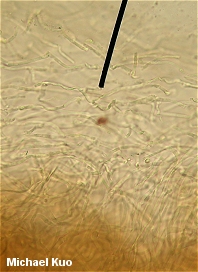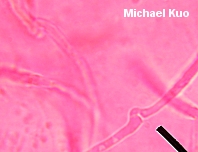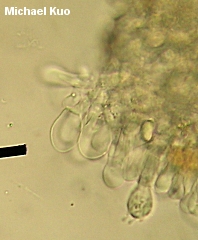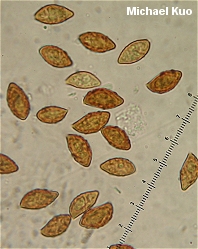| Major Groups > Gilled Mushrooms > Dark-Spored > Cortinarius > Cortinarius collinitus |

|
Cortinarius collinitus group [Basidiomycetes > Agaricales > Cortinariaceae > Cortinarius ... ] by Michael Kuo These days, when it seems as though almost every traditional mushroom species is being revealed as a group of phylogenetic species we may or may not be able to tell apart without a DNA sequencer (Lactarius gerardii and Cortinarius armillatus make good examples), it seems a bit silly to bother with the label "group" for a classic species like Cortinarius collinitus, first named in 1801 by Persoon. But not only is it clear that there are several (possibly many) species in Europe and in North America belonging to this group, but the concept of "Cortinarius collinitus" has been shifted, debated, applied, and misapplied by mycologists virtually from the moment the ink was dry on Persoon's treatment . . . leaving us with a fantastic mess of names and concepts. Until someone undertakes a thorough, contemporary study of these mushrooms, I think it's best to simply paint the group with broad strokes. Distinguishing features for the group include:
See the comments below regarding North American species names in this group, as well as the comments on the page for Cortinarius trivialis. Description: Ecology: Mycorrhizal with conifers or hardwoods; growing scattered or gregariously; summer and fall; widely distributed in North America. Cap: 3-9 cm; broadly conic to bell-shaped when young, becoming broadly bell-shaped or nearly convex; thickly slimy; bald; variable in color, ranging from fairly dark purplish brown when young and fresh to orangish brown or yellowish brown; the margin finely lined. Gills: Attached to the stem; close; lilac to pale purple at first, becoming brownish or rusty brown; often with whitish edges. Stem: 8-10 cm long; to nearly 2 cm thick; equal or tapering a little to the base; covered with lilac to purple slime when fresh; the slime often remaining as purplish patches, especially over the lower half--or disappearing to leave a whitish surface; often with a rusty ring zone. Flesh: Whitish to purplish. Odor and Taste: Not distinctive. Chemical Reactions: KOH negative on cap surface and on flesh. Spore Print: Rusty brown to medium brown. Microscopic Features: Spores 12-16.5 x 6.5-8 µ; football-shaped; moderately to strongly verrucose. Pleuro- and cheilocystidia absent. Marginal cells present. Pileipellis an ixocutis with conspicuously clamped elements. REFERENCES: (Persoon, 1801) Fries, 1838. (Saccardo, 1887; Smith, Smith & Weber, 1979; Arora, 1986; Phillips, 1991/2005; Lincoff, 1992; Evenson, 1997; Barron, 1999; Roody, 2003; McNeil, 2006; Miller & Miller, 2006; Trudell & Ammirati, 2009 [muscigenus].) Herb. Kuo 07220401, 07280405, 07250905, 06071003. Some of the North American species names that have been applied to members of the Cortinarius collinitus species group include: Cortinarius cylindripes Kauffman and Cortinarius muscigenus Peck (the latter name has ironically also been applied in Europe). The original descriptions of these species are below. Cortinarius cylindripes may be the best name for the oak-associated Illinois specimens illustrated on this page. See also Smith's 1944 discussion of the collinitus group (Lloydia 7: 163-235), as well as Kauffman (1918, 1932) and, for European treatments, Moser (1983), Hansen & Knudsen (1992), and Breitenbach & Kränzlin (2000). Peck, C. H. (1888), Annual Report of the New York State Museum 41: 71.
Kauffman, C. H. (1905), Bulletin of the Torrey Botanical Club 32: 321.
This site contains no information about the edibility or toxicity of mushrooms. |
© MushroomExpert.Com |
|
Cite this page as: Kuo, M. (2011, December). Cortinarius collinitus group. Retrieved from the MushroomExpert.Com Web site: http://www.mushroomexpert.com/cortinarius_collinitus.html |
